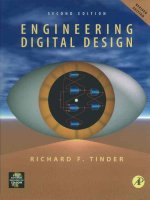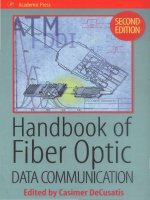strauss, r. (1998). smt soldering handbook - surface mount technology (2nd ed.)
Bạn đang xem bản rút gọn của tài liệu. Xem và tải ngay bản đầy đủ của tài liệu tại đây (2.62 MB, 389 trang )
job:LAY00 page:1 colour:1 black–text
SMT Soldering Handbook
job:LAY00 page:2 colour:1 black–text
mmmm
job:LAY00 page:3 colour:1 black–text
SMT Soldering Handbook
Rudolf Strauss, Dr.Ing., FIM
job:LAY00 page:4 colour:1 black–text
Newnes
An imprint of Butterworth-Heinemann
Linacre House, Jordan Hill, Oxford OX2 8DP
225 Wildwood Ave, Woburn, MA 01801-2041
A division of Reed Educational and Professional Publishing Ltd
A member of the Reed Elsevier plc group
oxford boston johannesburg
melbourne new delhi singapore
First published 1994 as Surface Mount Technology
Second edition 1998
© Rudolf Strauss 1994, 1998
All rights reserved. No part of this publication
may be reproduced in any material form (including
photocopying or storing in any medium by electronic
means and whether or not transiently or incidentally
to some other use of this publication) without the
written permission of the copyright holder except in
accordance with the provisions of the Copyright,
Designs and Patents Act 1988 or under the terms of a
licence issued by the Copyright Licensing Agency Ltd,
90 Tottenham Court Road, London, England W1P 9HE.
Applications for the copyright holder’s written permission
to reproduce any part of this publication should be addressed
to the publishers.
British Library Cataloguing in Publication Data
Strauss, Rudolf
Surface Mount Technology
I. Title
621.3815
ISBN 0 7506 35894
Library of Congress Cataloguing in Publication Data
Strauss, Rudolf.
Surface mount technology Rudolf Strauss.
p. cm.
Includes bibliographical references and index.
ISBN 0 7506 1862 0
1. Surface mount technology. 2. Printed circuits–Design
and construction. I. Title.
TK7870.15.S63
621.381531–dc20
93–44368
CIP
Typeset by Vision Typesetting, Manchester
Printed and bound in Great Britain by
Biddles Ltd of Guildford and King’s Lynn
job:LAY00 page:5 colour:1 black–text
Contents
Preface to the first edition xii
Preface to the second edition xiv
Glossary xvi
1 Why SMDs? 1
References 5
2 The SMD family 6
2.1 Shapes, sizes and construction 6
2.1.1 Melfs and chips 6
2.1.2 LCCCs 8
2.1.3 SOs and PLCCs 9
2.2 High-pincount components 9
2.2.1 TABs 10
2.2.2 Flip-chips and BGAs 11
2.3 Multichip modules 13
2.4 The solderable surfaces of SMDs 14
2.4.1 Melfs and chips 14
2.4.2 Components with legs 15
2.5 SMD shapes and wavesoldering behaviour 16
2.6 The popcorn effect 16
2.7 References 18
3 Soldering 20
3.1 The nature of soldering and of the soldered joint 20
3.1.1 The roles of solder, flux and heat 20
job:LAY00 page:6 colour:1 black–text
3.1.2 Soldering methods 21
3.1.3 Soldering success 24
3.2 The solder 24
3.2.1 Constituents, melting behaviour and
mechanical properties 24
3.2.2 Composition of solders for use in electronics 27
3.2.3 Lead-free solders 29
3.2.4 Solder impurities 31
3.3 The soldered joint 36
3.3.1 Soldering as a surface reaction between a
molten and a solid metal 36
3.3.2 Structure and characteristics of the soldered
joint 37
3.3.3 Mechanical properties of soldered joints 40
3.3.4 Soldering on surfaces other than copper 41
3.3.5 Long-term behaviour of soldered joints 43
3.3.6 Long-term reliability of soldered joints 44
3.4 The flux 45
3.4.1 Tasks and action of the soldering flux 45
3.4.2 Wetting and interfacial tension 47
3.4.3 Properties required in a flux 48
3.4.4 Rosin fluxes 50
3.4.5 Low-solids and no-clean fluxes 52
3.4.6 Watersoluble fluxes 53
3.4.7 Solvents used in fluxes 54
3.4.8 Flux standards 54
3.4.9 Testing soldering fluxes 57
3.5 Soldering heat 60
3.5.1 Heat requirements and heat flow 60
3.5.2 Heating options 61
3.6 Solderability 63
3.6.1 Wetting and dewetting 63
3.6.2 Capillarity and its effects 65
3.6.3 Capillarity and joint configuration 65
3.6.4 The importance of solderability 69
3.6.5 Oxide layers 69
3.6.6 Solderability-enhancing surface coatings 71
3.6.7 Leaching effect of molten solder 73
3.6.8 Measuring solderability 74
3.7 References 81
vi Contents
job:LAY00 page:7 colour:1 black–text
4 Wavesoldering 84
4.1 The wave concept 84
4.1.1 Wavesoldering before SMDs 84
4.1.2 Wavesoldering after SMDs 85
4.2 Applying the flux 87
4.2.1 Types of fluxer 87
4.2.2 Monitoring and controlling flux quality 96
4.3 Preheating the board 98
4.3.1 Heat requirements 98
4.3.2 Heat emitters and their characteristics 100
4.3.3 Temperature control 102
4.4 The solderwave 103
4.4.1 Construction of the soldering unit 103
4.4.2 Thermal role of the solderwave 104
4.4.3 Interaction between molten solder and the
circuit board 105
4.4.4 Chipwaves 110
4.4.5 Formation and control of dross 114
4.5 Wavesoldering in an oxygen-free atmosphere 118
4.5.1 Origins and development 118
4.5.2 Wavesoldering in nitrogen 119
4.6 Board conveyor systems 126
4.6.1 Functional requirements 126
4.6.2 Board-handling systems 126
4.7 Wavesoldering practice 130
4.7.1 Operating parameters and their role 130
4.7.2 Choosing and monitoring operating parameters 131
4.7.3 Optimizing machine parameters 136
4.7.4 Machine maintenance 137
4.7.5 Check-analysis of the solderbath 138
4.7.6 Dealing with dross 138
4.7.7 Hygiene and safety 139
4.8 The role of adhesives in wavesoldering 141
4.8.1 Demands on the adhesive and the glued joint 141
4.8.2 Storage and handling behaviour of adhesives 141
4.8.3 Applying the adhesive 143
4.8.4 Curing the adhesive joint 145
4.8.5 The glass transition temperature 146
4.9 References 147
5Reflowsoldering 148
5.1 The reflow concept 148
Contents vii
job:LAY00 page:8 colour:1 black–text
5.1.1 SMDs and reflowsoldering 148
5.1.2 Reflowsoldering versus wavesoldering 154
5.2 Solder paste 158
5.2.1 Operational requirements 158
5.2.2 Standard specifications 159
5.2.3 Solderpowder 160
5.2.4 The flux and its residue 164
5.2.5 Printing and dispensing properties 165
5.2.6 The solderball test 167
5.3 Putting the solder paste on the board 169
5.3.1 Single-spot dispensing 169
5.3.2 Stencilling and screen printing 171
5.3.3 Depots of solid solder 178
5.4 Vapourphase soldering 179
5.4.1 The basic concept 179
5.4.2 Vapourphase working fluids 180
5.4.3 The physics of vapourphase soldering 180
5.4.4 Vapourphase soldering equipment 184
5.4.5 ‘New-generation’ vapourphase soldering
systems 186
5.5 Infrared soldering 189
5.5.1 Working principle 189
5.5.2 The physics of heat transfer by radiation 191
5.5.3 The physics of heat transfer by convection 200
5.5.4 Operation of infrared ovens 201
5.5.5 Oven design 203
5.5.6 Infrared soldering in a controlled atmosphere 208
5.6 Reflowsoldering with hot air or gas 209
5.6.1 Convection versus radiation 209
5.6.2 The physics of convection reflowsoldering 210
5.6.3 Convection reflow ovens 210
5.6.4 Development potential of convection
reflowsoldering 212
5.6.5 Convection soldering of single components 214
5.7 Laser soldering 217
5.7.1 How a laser works 218
5.7.2 Nd: YAG and CO
lasers 218
5.7.3 Laser soldering in practice 220
5.7.4 Laser-soldering equipment 221
5.8 Impulse soldering 223
5.8.1 Operating principle 223
5.8.2 The solder depot 224
viii Contents
job:LAY00 page:9 colour:1 black–text
5.8.3 The thermode and its heating cycle 225
5.8.4 Impulse-soldering equipment 227
5.9 SMD soldering methods – A survey 228
5.10 References 232
6 The circuit board 234
6.1 The beginnings 234
6.2 SMD-specific demands on a circuit board 234
6.3 Thermal management 236
6.3.1 Thermal expansion mismatch 237
6.3.2 Effects of temperature differences between
components and board 237
6.4 Solderable surfaces 238
6.4.1 Galvanic coatings 239
6.4.2 Hot tinning 239
6.4.3 Organic coatings 241
6.4.4 Flat solder depots 242
6.5 The soldermask 244
6.6 Layout 244
6.6.1 Layout for wavesoldering 244
6.6.2 Layout for reflowsoldering 247
6.7 References 249
7 Component placement 250
7.1 The task 250
7.2 Reliability of placement 251
7.3 Placement options 253
7.3.1 Fully manual placement 253
7.3.2 Semi-automatic placement 255
7.3.3 Fully automatic sequential systems 256
7.3.4 Simultaneous placement systems 257
7.4 The practice of automatic component placement 258
7.4.1 The range of choice 258
7.4.2 Classes of placement machines 259
7.5 Reference 260
8 Cleaning after soldering 261
8.1 Basic considerations 261
8.1.1 Reasons for cleaning 263
8.1.2 Designing for cleanability 266
8.1.3 What must be removed? 267
8.2 The theory of cleaning 269
Contents ix
job:LAY00 page:10 colour:1 black–text
8.2.1 The physics of cleaning 269
8.2.2 The chemistry of cleaning 274
8.3 The practice of solvent cleaning 276
8.3.1 Organic solvents 277
8.3.2 Solvent-cleaning installations 282
8.3.3 In-line cleaning plants 288
8.3.4 Halogenated solvents: safety and health 291
8.3.5 The three environmental threats 293
8.3.6 Restrictions on solvent usage 297
8.3.7 Non-flammable organic solvents with reduced
environmental risks 298
8.3.8 Flammable solvents 299
8.4 Cleaning with water 302
8.4.1 Chemical and physical aspects 302
8.4.2 Water quality 303
8.4.3 Water recycling and effluent problems 305
8.4.4 Removal of residue from watersoluble fluxes 306
8.4.5 Removal of residue from resinous fluxes 306
8.4.6 Water washing installations 307
8.5 Semi-aqueous cleaning 310
8.5.1 The concept 310
8.5.2 The cleaning solvents 311
8.5.3 Semi-aqueous washing installations for
water-immiscible solvents 313
8.5.4 Semi-aqueous washing installations for
water-miscible solvents 315
8.6 Testing for cleanliness 318
8.6.1 The meaning of cleanliness 318
8.6.2 Measuring ionic contamination (MIL test) 319
8.6.3 Measuring surface insulation resistance (SIR) 321
8.7 The future of cleaning and of fluxing 322
8.8 References 323
9 Quality control and inspection 325
9.1 The meaning of ‘quality’ 325
9.1.1 Product quality and product reliability 325
9.1.2 Classification according to reliability
requirements 326
9.2 Soldering success and soldering perfection 327
9.2.1 Soldering success and soldering faults 327
9.2.2 Soldering perfection and soldering imperfections 330
9.3 Practical examples of soldering faults 332
9.4 The ideal and the imperfect joint 332
x Contents
job:LAY00 page:11 colour:1 black–text
9.5 Inspection 332
9.5.1 When to inspect 335
9.5.2 Visual inspection 337
9.5.3 Automated opto-electronic inspection 338
9.5.4 X-ray inspection 338
9.5.5 Electronic inspection 340
9.5.6 Thermographic inspection 340
9.6 References 340
10 Rework 342
10.1 The unavoidability of rework 342
10.1.1 Rework in the production process 342
10.1.2 Desoldering and resoldering 343
10.2 Basic considerations 343
10.2.1 Metallurgical and mechanical consequences of
rework 343
10.2.2 The cost of rework 344
10.2.3 Lessons to be learned 344
10.3 Rework equipment 345
10.3.1 Heat sources 345
10.3.2 Rework stations 347
10.4 Rework tasks and procedures 348
10.4.1 Removing bridges and solderballs 348
10.4.2 Desoldering SMDs 348
10.4.3 Filling empty joints 353
10.4.4 Resoldering SMDs 356
10.4.5 Cleaning after rework 358
10.4.6 Semi-mechanized work stations 359
10.5 Integrating rework into the production process 360
10.5.1 Rework personnel 360
10.5.2 Closed-loop soldering 361
10.6 References 361
Index 363
Contents xi
job:LAY00 page:12 colour:1 black–text
Preface to the first edition
This book has been written for all those who have to solder surface mounted
devices to circuit boards, and it should therefore be of interest to practi-
tioners of soldering in all its various forms. Apart from them, people
concerned with inspection and quality control, or with the choice and
acquisition of equipment, may find some sections of the book useful.
I have tried to cover all the practicalities of soldering in electronic
manufacture in such a way and such language, that it can be read and, I hope,
understood by those in direct charge of assembling circuit boards by solder-
ing. Temperatures are given in degrees Centigrade and Fahrenheit; as a rule,
operating temperatures are rounded up or down to the nearest round figure,
unless they relate to physical constants such as melting or boiling points.
Dimensions are given both in metric and imperial units.
Since it is in the first place about soldering, the book covers all aspects of
the soldering process itself, which include principally solders, fluxes, solder-
ing heat and solderability. Because it deals with the soldering of SMDs, it
describes the dimensions and features of these components as far as they are
relevant to soldering. What goes on inside an SMD is of no concern here.
All practical and, as far as is necessary, the theoretical aspects of wavesol-
dering and of the various methods of reflowsoldering are comprehensively
treated. Features of the circuit board and of component placement are
considered as far as they are relevant to the soldering process.
Cleaning after soldering is treated in detail. The text is based on the state
of the art, which this quickly evolving technology had reached by the
middle of 1993. The restrictions on the use of cleaning media and methods,
which the book mentions, are those which were in force or anticipated at
that point in time.
Practitioners of soldering need to know what constitutes a ‘good’ joint,
and how to correct soldering defects. Therefore, quality control and inspec-
job:LAY00 page:13 colour:1 black–text
tion are discussed in detail, as is corrective soldering. Some readers may find
the contents of these sections of the book provocative or controversial. This
was difficult to avoid, because I hold strong views in these matters, many of
them based on practical experience.
My own interest and involvement in soldering go back a long time.
Having studied experimental physics, as it was then called, in Germany in
the mid-thirties, I joined and later managed the research department of a
leading smelter of alloys of lead, tin and copper, when I came to London in
1939. During the war, which broke out soon after, I was involved in the
development of the new technologies and materials which it demanded,
many of them related to soldering.
In the mid-1950s, I was closely associated with the invention and intro-
duction by my company of wavesoldering of printed circuit boards, which
themselves had been invented during the war by Paul Eisler in London. My
involvement with electronic soldering continued until my retirement in the
mid-seventies. My engagement in consultancy, lecturing, and writing, still
on that same subject, continues.
A large number of friends and former colleagues have given me much
help, advice and support in writing this book, and I have drawn on the
published work of several of them. My thanks are due to them all. They are
too numerous to mention individually, but I must single out Dr Wallace
Rubin of Multicore Solders Ltd for guiding me through the maze of the
standard specifications of solders and fluxes, and Russ Wood, formerly of
Dage (GB) Ltd, and Gordon Littleford, formerly of Kerry Ultrasonics Ltd,
who have put me right on the finer points of today’s cleaning technology.
Finally, my special thanks are due to Dr Colin Lea of the National
Physical Laboratory in Teddington, who never hesitated to let me draw on
his and his colleagues’ wide fund of scientific knowledge.
Rudolf Strauss
Preface to the first edition xiii
job:LAY00 page:14 colour:1 black–text
Preface to the second edition
There have been drastic changes in the various technologies covered in this
book since its first edition appeared some three years ago. The growth of the
market in electronic products has not slackened and its global monetary
value is expected to overtake that of the automotive industry before the year
2000. Driven by market forces, electronic assemblies have become progress-
ively smaller; 30 per cent of all electronic products, such as mobile tele-
phones, camcorders, lap-top computers and electronic notebooks are now
‘handheld’; the universal use of electronic ‘smart cards’ is imminent. The
result is miniaturization, the crowding of an ever increasing data storage and
handling capacity into devices which fit into a pocket or the palm of a hand.
Soldering is still the dominant joining technology, but soldered joints are
moving ever closer together. Wavesoldering has reached the limits of its
capabilities, and reflowsoldering has become the leading technique.
Another effect of the pressure of the marketplace is the shortened life
expectancy of many electronic products. The demand for constant innova-
tion in the fields of video and audio products, communication, office and car
electronics and many other areas such as military, means that any given item
may become obsolete well before the end of its natural lifespan. Interest in
the long-term behaviour of soldered joints has therefore noticeably
slackened. Instead, the mounting bulk of scrapped electronic equipment is
beginning to worry the environmentalists, who are the driving force behind
the search for lead-free solders. This second edition takes account of these
changes. Like the first one, it aims to present the practical problems, which
the practitioner of soldering has to face and solve, in simple terms and plain
language, free from technical jargon.
Once again, I have to thank many of my friends and former colleagues for
their help and advice. Dr Wallace Rubin, and Dr Malcolm Warwick of
job:LAY00 page:15 colour:1 black–text
Multicore have brought me up to date on much of current industrial
practice, and on the present state of American and European standard
specifications relating to solder alloys and soldering fluxes. The staff of ITRI
Ltd (formerly the International Tin Research Institute) have been most
helpful in guiding me on my way in the world of lead-free solders. My
special thanks go to Professor Theodore L. Bergman, of the University of
Connecticut USA, who pointed out a serious misconception of mine in the
first edition of this book, relating to the absorption of infrared radiation in
the atmosphere of a reflowsoldering oven. This error has been corrected in
this second edition.
Rudolf Strauss
Preface to the second edition xv
job:LAY00 page:16 colour:1 black–text
Glossary
As is characteristic of any upwardly mobile technology, its practitioners are
continuously coining new technical terms and abbreviations, which are
given a more or less agreed meaning. It will be useful to provide a necessarily
limited list of them at this point.
I/O, IOASIC Application-specific integrated circuit
BGA Ballgrid array: a plastic or ceramic body containing an IC, with
its IOs, in the form of solder bumps, located on its underside
CC Chip-carrier: a square-bodied, plastic or ceramic SMD, with an
IC inside
Chip The term ‘chip’ has acquired several meanings, among them the
following: an IC on a ceramic substrate; an SMD which contains
an IC; a resistor or ceramic capacitor, encased in a rectangular
ceramic body. Unless expressly stated, the term ‘chip’ will always
have this last meaning in this book
COB Chip-on-board: a bare chip, glued to a board and connected to
its circuitry by wirebonding
CSP Chip-size package: an SMD with a plastic or ceramic body
which is not much larger than the chip which it contains
DCA Direct chip attach (an alternative name for flip chip)
DIL ‘Dual-in-line’: a through-mounted device (TMD) containing an
integrated circuit with two parallel lines of legs
FP Flip chip: a bare chip with solder-bumps on its underside. Like a
BGA, it can be reflowsoldered directly to a circuit board
IC Integrated circuit: an electronic circuit carried on the surface of a
silicon wafer
I/O, IO In/out: the solderable connectors or leads of an SMD
job:LAY00 page:17 colour:1 black–text
MCM Multi-chip module: an array of interconnected ICs, mounted on
a common substrate, such as a multilayer PCB, or a silicon,
ceramic or glass wafer, to be soldered to a circuit board
Melf A ‘metal electrode face-bonded’ component: a resistor or a
diode, encased in a cylindrical ceramic body with metallized
solderable ends
PCB Printed circuit board
PLCC Plastic leaded chip carrier: a CC with a body made of plastic,
with J-shaped legs on all four sides
QFP Quad flatpack: a plastic body containing an IC, with gull-wing
legs on all four sides
SMD A surface-mounted device
SO ‘Small outline’: an SMD, with a plastic body, carrying gull-wing
legs on opposite sides
SOIC An SO, with an IC (usually with a 1.25 mm/50 mil pitch)
SOT An SO transistor
TMD Through-mounted device: a component with connecting wires
or legs, which are inserted into the through-plated holes of a
circuit board
VSOIC ‘Very small outline’: a fine-pitch SOIC
Glossary xvii
job:LAY00 page:18 colour:1 black–text
mmmm
job:LAY01 page:1 colour:1 black–text
1 Why SMDs?
The relationship between the manufacturers of electronic components and the
assemblers of electronic circuitry resembles that between two different orders of
living beings, for example insects and plants: they need one another to be able to
exist, and for that reason there are close links between the evolutionary paths of
both. The shapes and the dimensions of their bodies, or respectively their functions,
must match one another, so that whatever is needed to ensure the survival of either
species can be properly performed. Any mistakes or mismatches are punished by
extinction.
Here the similarity ends: the evolutionary paths of plants and animals started to go
their different ways over three hundred million years ago. The evolutionary periods
in the world of electronics are measured in units smaller than decades, sometimes
years. Also, bees and flowers cannot talk to one another; the designers and makers of
components and the designers and makers of electronic assemblies can and should.
Sometimes, in the past, maybe not often enough, but now very close cooperation is
the rule. Unless this communication develops into a continuing, orderly and
purposeful dialogue, extinction of isolated species with insufficient evolutionary
mobility continues to be a threat. At the other end of the mobility scale, a few large
manufacturing houses have managed to bring three orders of electronic species
together into one closely-knit symbiosis: components, component-placement
equipment, and electronic assemblies are all designed, made, used and marketed by
one single vertically-structured organization.
The particular branch of electrical engineering, which from about 1905 onwards
was called ‘electronics’, could be said to have begun with the transmission of the first
Morse signal across the Atlantic by Marconi, on 12 December 1901. Then, as now,
one of the principal uses of electronics was the creation and transmission of signals.
Then, as now, the basic constructional elements of electronic apparatus were of two
kinds, components and the conducting links between them. On the one hand there
were active devices such as spark-gaps, later on thermionic valves and passive
components like inductive tuning and coupling coils, capacitors, and resistors. On
the other hand there was a tangle of wires which connected these devices with one
another. Judging by contemporary drawings and photographs, the style of these
installations, whether landbased or on board a ship, was that of a rather untidy
job:LAY01 page:2 colour:1 black–text
Figure 1.1
Component on a single-sided circuit board
laboratory. The terminals of the various electronic devices were usually screw
connectors.
After the First World War, radio started to develop as a vehicle for the trans-
mission of news and entertainment to the public at large. To begin with, most
receivers were assembled by domestic amateurs, who soldered connecting wires to a
set of components supplied by their makers, complete with the necessary wiring
diagrams. Industrial manufacture of domestic receivers and electronic apparatus in
general began in the early twenties.
Soldering was the universal method of joining the connecting wires to the
component terminals. An electronic apparatus was a three-dimensional assembly:
the valves, coils, and resistances were all fairly large, measuring several inches across
and in height, and their terminals were not always close together or in one plane.
Soon they began to be assembled together on a common chassis, and the connecting
wires were prefabricated as a three-dimensional wiring loom. Teams of skilled
operators, mainly girls, handsoldered the wire ends to the component terminals,
which themselves were either short wires or soldering lugs. They worked with
electric soldering irons and solderwire with a rosin-flux core. Soldering quality on
the whole was excellent, because every operator was his (or her) own quality
inspector: she would not lift the iron off a joint until she had seen the solder flow
into it. Making a wrong connection was the main danger.
The three-dimensional nature of electronic assemblies had two consequences:
they did not lend themselves to mechanized mass production (though some at-
tempts were made) and post-assembly inspection was almost impossible. Testing
was functional, and the location of faults was a skill, not a science.
Paul Eisler’s invention of the printed circuit in 1943 (Section 6.1) changed all
that: he replaced the three-dimensional wiring loom with a two-dimensional
pattern of thin strips of copper foil, carried on one side of an insulating phenolic
paper board. Wherever a conductor had to be soldered to the terminal of a
component, a hole was drilled into the board, and surrounded by a ring of
conductor foil, the ‘land’. The components, which at that time were axial resistors,
axial or radial capacitors, sockets for thermionic valves and, increasingly, three-
legged transistors, were placed on the other side of the board with their terminal
wires pushed through their appropriate holes in the board. Their protruding ends
were crimped over the lands, which surrounded the holes, and soldered to them,
one by one (Figure 1.1). Again, teams of girls inserted the components, crimped the
2 Why SMDs?
job:LAY01 page:3 colour:1 black–text
wire ends and handsoldered them to the lands on the board. Rules were established
for what a good joint should look like, and some of these rules persist to this day
(Chapter 9).
Because all the joints of the assembly were in one plane, soldering all of them in
one operation was the obvious next step. This was made possible by the invention
of wavesoldering in 1956 (Section 4.1). From then on, the forward march of the
printed circuit board became unstoppable, and it soon conquered the world.
However, the assembly itself was still three-dimensional. Though the circuit
pattern was in two dimensions, the thermionic valves, later the transistors, and all the
resistors and capacitors were sitting on it like houses on a flat piece of ground, with
their terminal sticking through it. Surface-mounted resistors stuck to circuit boards
had been described in 1952, but the first mention of a device with its terminals in
contact with conductors on a circuit board occurs in a British patent in 1960.
In the mid sixties, the growth of hybrid technology provided the incentive to
design surface-mounted devices which had no connecting wires. Thick-film
circuitry, carried on ceramic wafers, provided a rugged basis for electronic assem-
blies for use in demanding environments. Because it was impracticable to provide
the wafers with holes, the components had to be surface mountable by necessity. To
begin with, some of them were simply wired components with their legs cut off,
like melfs. Others were already purpose-designed for mounting on ceramics, like
chips.
SOs with their angled legs came soon after chips and melfs, followed by PLCCs.
They were the direct descendants of the DILs, and the pitch of their legs is still
1.27 mm/50 mil, like that of the DILs. All of them are decidedly three-dimensional,
and obviously originally conceived for handsoldering. The component manufac-
turers issued detailed soldering advice, but left it to the makers and users of
wavesoldering machines to cope with the problems caused by the three-dimen-
sional nature of the components (Section 4.1.2).
In spite of these problems, and the initial reluctance of the assembling industry to
cope with them, the advance of SMDs was as unstoppable as that of the printed
circuit board twenty years earlier. With the arrival of integrated circuits and their
multiple functions, the number of component legs – their pincount – began to grow
beyond the 68 legs which were manageable with the old 1.27 mm/50 mil pitch, and
this signalled the approaching end of the species of inserted components with their
legs or wires stuck into holes drilled in a board. Surface-mounting technology
(SMT) began to take over. At the same time, components became flatter, and
approached the two-dimensionality of the boards on which they sit. The designers
of soldering equipment and of SMDs had started to work together. TABs are a
typical example of the benefits of this cooperation.
Today, a number of driving forces, which are pushing SMT further forward, can
be discerned:
1. Related to the individual component: large-scale integration of chips
and high switching rates demand short leads of roughly equal lengths. This
requirement can only be met with the close-pitch design of QFPs (quad flat
packages) and TABs (tape automated bonding packages) (Figure 1.2).
Why SMDs? 3
job:LAY01 page:4 colour:1 black–text
Figure 1.2
DIL and PLCC. (a) 64–lea d DIL, 2.54 mm/100 m i l pitc h; (b) 68– lea d PLCC ,
1.27 mm/50 mil pitch (Philips)
2. Related to the assembly as a whole: the number of functions per
component, and consequently per assembly, has grown almost exponentially
over the years since the introduction of SM technology. A fine-pitch-
technology board is many times smaller than a board with the same functions
but populated with inserted components only. Electronic devices like the
controls for a camcorder, the circuitry of a mobile telephone, or a
pacemaker, are unthinkable without SMT.
3. Related to circuit manufacture: automatic insertion of fine-pitch wired
components, even if they did exist, would pose insurmountable difficulties.
The use of SMDs is still growing steadily, having overtaken inserted components in
1992. The forecast from which Figure 1.3 is reproduced predicted a strong growth
of the chip-on-board technique, by which bare chips are placed on the circuit board
4 Why SMDs?
job:LAY01 page:5 colour:1 black–text
Figure 1.3
Forecast of electronic component usage (from Surface Mount
Technology, BPA Ltd, Dorking RH4 1DF, UK Feb. 1989)
and their IOs are connected with their footprints by wirebonding (COB = chip-on-
board). This technique has meanwhile been overtaken by BGAs and flip–chips, for
reasons explained in Section 2.2. Since this book is devoted entirely to sur-
facemounting by soft soldering, surface attachment methods such as wirebonding
and using conducting adhesives are outside its scope.
As of now, almost all SMDs are connected to the conductor pattern of the board
on which they sit by soldering. Alternative joining techniques, such as wirebonding
in the case of COB constructions, or joining with a conductive, adhesive polymer,
or even elastomer, have established a toehold in SMD technology, which will
almost certainly grow in the future. This present book, however, is confined to
soldering as the method of joining components to the conductor pattern on the
circuit board.
References
1. Anon. (1952) Adhesive Resistors, Circuit World (UK), Feb. 1952, p. 70.
2. Brit. Patent 853 987, Nov. 1960.
3. Kirby, P. L. and Pagan, I. D. (1987) The Origins of Surface Mounting. Proc.
Europ. Microelectron. Conf., Bournemouth, UK, June 1987.
4. Slyman, D. A. (1996) Anisotropic Conductive Adhesives. Productronic 10/96,
pp. 30–36.
Why SMDs? 5
job:LAY02 page:2 colour:1 black–text
2 The SMD family
Like all electronic components, surface-mounted devices (SMDs) can be classified
according to their function.
Passive components include resistors, capacitors and inductors, all of them bipolar
devices. Active components have three or more terminals, apart from diodes which
have two. Basically, active devices contain switches or gates. These can number
from the one of a single transistor with its three leads up to 25 000 for gate arrays
with three hundred leads, or 250 000 for memories with about thirty leads.
A detailed discussion of the function and internal construction of SMDs is outside
the framework of this book, which is concerned with the problem of soldering
SMDs to circuit boards. Therefore, it is the shapes and the solderable surfaces of
these SMDs which are our main interest. Components for direct attachment
techniques like ‘naked’ chips for ‘chip on board’ mounting, are also outside the
scope of this present book because they are connected to the circuit board not by
soldering but by a wirebonding technique.
2.1 Shapes, sizes and construction
SMDs come in three basic shapes: short cylinders, rectangular blocks and flat slabs.
Table 2.1 lists them, together with their main characteristics, and sketches their
main features. The names by which they have become known have emerged as they
were developed, and for this reason they do not follow any logical scheme.
2.1.1 Melfs and chips
Cylindrical SMDs, made solderable by thick-film metallization or metallic caps at
either end of their ceramic or glass bodies, are known as melfs (Metal Electrode
Faced components). A small proportion of melfs are bipolar diodes with glass
bodies, metal endcaps, and markings indicating their polarity. To ensure correct
placement, diodes are packed in blistertape. SMDs with small square ceramic bodies
are called chips. Their endfaces are metallized by thick-film metallic deposit.
job:LAY02 page:3 colour:1 black–text
Table 2.1 The SMD family
Shape Nature, Number Pitch Body, size Soldering
name of IOs mm/inch mm/inch method
Passive Ceramic
Melf 2 — 5.0 ; 2.22 dia./ W,R
0.2 ; 0.08 dia.
Mini 2 — 3.6 ; 1.4 dia./ W,R
melf 0.14 ; 0.06 dia.
Micro 2 — 2.0 ; 1.1 dia./ W,R
melf 0.08 ; 0.04 dia.
Active Glass
SOD 2 3.5 ; 1.6 dia./ W,R
0.14 ; 0.64 dia.
to
5.0 ; 2.3 dia./
0.2 ; 0.09 dia.
Passive 2 — 1.25 ; 2.0/ W,R
chips 0.05 ; 0.08
to
5.7 ; 5.0/
0.23 ; 0.2
Active Plastic
SOT 3–4 — 3.0 ; 1.3/ W,R
0.12 ; 0.05
SO, 6–28 1.27/ 4.0 ; 5.0/ W,R
SOIC 0.050 16 ; 0.2 to
7.6 ; 18/
0.3 ; 0.72
VSO 40–56 0.75/ up to 11 ; 21/ W,R
0.030 0.44 ; 0.85
SOJ, 20–84 1.27/ up to W,R
PLCC 0.050 29.4 ; 29.4/
1.16 ; 1.16
The SMD family 7









